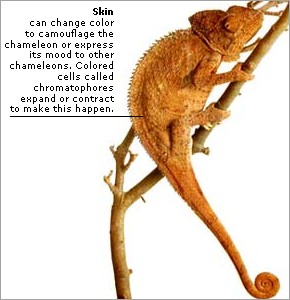DK Nature: Reptiles
This group of scaly-skinned, backboned animals includes snakes, lizards, crocodiles, hard-shelled turtles, and the tuatara, from New Zealand. Most reptiles live on land, but turtles, crocodiles, and some snakes live in water. Nearly all reptiles are equipped with senses similar to humans.
Most reptiles are active predators. Lizards hunt mainly insects. Snakes target prey such as rodents and birds. Some snakes subdue their victims with VENOM. Crocodiles prey on creatures as large as wildebeest. Turtles and terrapins eat mainly fish and invertebrates. Tortoises, which live on land, feed mostly on plants.
Many reptiles hide, or are camouflaged to blend in with their surroundings. Some are speedy and agile, and can scurry off at lightning speed. Others are brightly colored to warn predators that they are poisonous. Some lizards can break off their tail in order to escape, growing a new one through REGENERATION.
Turtles live in water and tortoises live on land. Turtles from the same scientific family as tortoises are sometimes called terrapins. Terrapins have clawed feet and live in freshwater habitats. Tortoises, turtles, and terrapins have changed little in 200 million years. They all have bony or leathery shells.
Most reptiles lay eggs, but in a few snakes and lizards, the eggs develop inside the mother’s body so that she gives birth to live young. Crocodiles and tortoises lay hard-shelled eggs similar to bird’s eggs. Turtules, snakes, and most lizards lay eggs with softer leathery shells. Sea turtles lay their eggs on beaches.
The 22 species of crocodiles and their relatives are fearsome predators. Crocodiles ambush large prey. They snatch victims from the water’s edge and drag them under to drown them. Crocodiles cannot chew, but may spin around to break the victim’s body into pieces.
| There are around 6,000 species of reptiles, split into four different orders. |
| Snakes and lizards belong to the same order—Squamata. There are around 3,000 species of lizards and 2,500 species of snakes. |
| The second-largest order, Chelonia, includes all turtles, tortoises, and terrapins. |
| Crocodiles and their relatives make up the order Crocodilia. |
| The tuatara is the last living member of its order. The rest died out 100 million years ago. |
The majority of snakes kill their prey with venom produced by glands in their heads. The glands pump poison through long, pointed teeth called fangs, which bite deep into their prey.
Fewer than 10 percent of snakes produce venom strong enough to kill a person. Vipers produce large quantities of venom—people bitten by diamondback rattlesnakes have been known to die in under an hour. The Australian inland taipan is thought to be the world’s most deadly snake. Sea snakes are also highly poisonous, but they rarely bite humans.
Snake venom works on victims in two main ways. The venom of snakes such as vipers causes death by damaging the prey’s body tissues and blood. Other snakes produce neurotoxins, which attack the victim’s nervous system, paralyzing the heart, breathing system, and muscles.
Some animals are able to regenerate (regrow) tails, limbs, or other body parts lost in accidents or bitten off by predators. Among vertebrates (backboned animals), these species include lizards such as the tree skink (a kind of lizard) and the salamander (an amphibian).
Losing all or part of the tail is a defense mechanism for some species of lizards. If grabbed by a predator, the tail breaks off at a fracture point, which minimizes bleeding, and continues to wriggle, distracting the predator while the lizard escapes. Within nine months, the tail regrows, stiffened by cartilage instead of bone.
Starfish, sponges, flatworms, and crabs can also regrow body parts severed in accidents. Sponges have an even more amazing ability. When passed through a fine mesh, these simple multicellular animals are able to reassemble themselves. The cells seek each other out and join back together.





